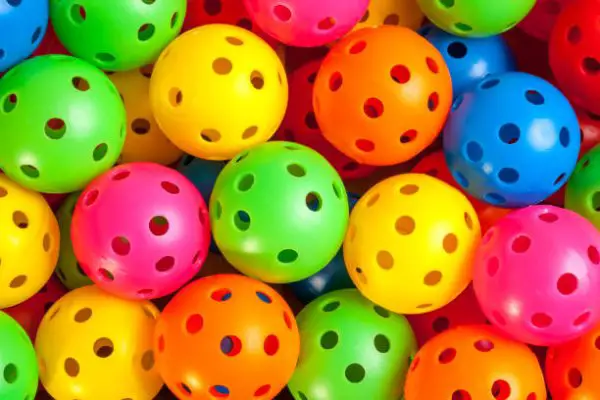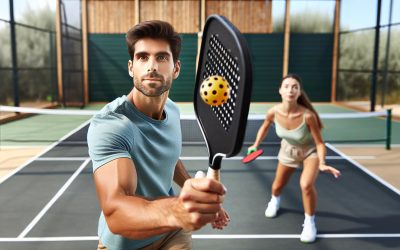Ever wondered what makes pickleball such a unique sport? For one thing, it’s the ball! Pickleball balls are specifically designed for this fast-paced, exciting game. They’re not your average sports balls, and that’s what makes them so intriguing.
Indoor pickleball balls, in particular, have their own set of characteristics. They’re lighter, softer, and have fewer holes than their outdoor counterparts. Understanding these differences is crucial for any pickleball enthusiast looking to master the game.
Whether you’re a seasoned pro or just starting out, knowing your equipment is key. Let’s delve into the world of pickleball balls, and find out why they’re the heart and soul of this thrilling sport.
What Makes Pickleball Balls Unique
Before diving deep into the unique aspects of pickleball balls, it’s important to understand that the sport of pickleball is a combination of elements from tennis, badminton, and table tennis. This might make an outsider think that any small hollow ball would fit the bill. However, that’s not true. So, you may then ask, what makes pickleball balls special?
For starters, pickleball balls are meticulously engineered. They aren’t just random balls picked off retail store shelves. An authentic pickleball ball goes through rigorous testing before it’s deemed fit for the sport. Pickleball balls have specific weight, bounce, hardness, and size standards they must meet to receive the ‘official’ stamp from the USA Pickleball Association.
Every pickleball ball is designed to possess a unique ‘flight pattern’ that can withstand the sport’s fast-paced nature. It’s about precision and durability; the ball’s holes are engineered in such a way that they reduce wind disturbance, maintaining the direction of the ball with minimal deviation.
Besides these aspects, another defining characteristic of pickleball balls is the number of holes they contain. While the standard count is anywhere between 26 to 40 holes meticulously drilled into them, the hole arrangement varies between indoor and outdoor balls. The hole configuration plays a significant role in determining the ball’s movement.
Indoor pickleball balls, typically softer and lighter with larger holes, are engineered to be responsive and agile. This design comes in handy due to the indoor conditions they’re used in, considering the lesser effect of wind resistance. They’re optimized for controlling the game as they’re slower and easier to hit.
Meanwhile, outdoor pickleball balls, having smaller, denser holes and a tougher build, are built to resist the unpredictable outdoor conditions they’re exposed to. Hence, they’re often heavier and harder, adding speed to the game and providing a sturdy and predictable bounce.
What really makes pickleball balls stand out is their tailor-made approach. From structure to size to the number and configuration of holes, they have a specificity that empowers players to excel in varied conditions. This goes on to assert the importance of understanding your pickleball gear well and making informed choices — an aspect that’s integral to mastering this fun, exciting sport.
Characteristics of Indoor Pickleball Balls
Diving deeper into the differences in pickleball balls, indoor pickleball balls have some specific characteristics. They’re designed meticulously to meet indoor playing conditions. Understanding these particular features will help you master the game beneath the roof.
Indoor balls are characteristically softer and lighter compared to the balls used for outdoor games. This difference is a result of the smoother, less abrasive surfaces found indoors. The softer makeup helps reduce bounce and allows for more controlled, strategic play.
Moreover, these balls have larger holes. Size does matter, especially when talking about the holes in a pickleball ball. The larger hole configuration on indoor balls helps in reducing the ball speed and wind resistance while increasing maneuverability. Simply put, the larger holes make the ball more responsive to paddle strikes.
Another unique characteristic of indoor pickleball balls is their average weight and bounce. Generally, they weigh around 0.85 ounces and have a bounce of 37 inches after dropping from a height of 78 inches. Let’s have a look at the comparison between indoor and outdoor pickleball balls in the following table:
| Property | Indoor Ball | Outdoor Ball |
|---|---|---|
| Weight | 0.85 ounces | 0.88 to 0.92 ounces |
| Bounce height | 37 inches | Between 31 to 33 inches |
This comparison clearly shows the variance between the two types of balls. Indoor balls emphasize precision and control during play, whereas outdoor balls cater to durability and environmental resistance.
As the selection of the right pickleball ball type largely affects your gameplay, remember, it’s not just about getting the ball over the net. It’s also about understanding the game elements the ball brings on different playing fields. So, next time you’re playing indoors, note how the ball’s attributes mentioned above affect your gameplay.
Differences Between Indoor and Outdoor Pickleball Balls
It’s integral for every pickleball enthusiast to understand the significant distinctions between indoor and outdoor pickleball balls. With knowledge of these differences, I can adapt my gameplay and strategy accordingly.
Indoor balls are typically softer and lighter with larger holes. This softness reduces the bounce, helping with a more strategic and controlled playstyle. Indoors, where you’re playing in a relatively confined space, the speed of the game likely plays slower—this is where a softer, lighter ball comes into play.
On the other hand, outdoor balls, crafted for harsher weather conditions, are typically harder with smaller holes. The smaller perforations in the outdoor ball help it sail through a windy day without veering off course.
Both weight and bounce height are two critical aspects of a pickleball ball’s performance.
Outdoor balls are slightly heavier and have a higher bounce. Heavier and harder balls handle the elements better as they resist wind and sun—more common factors in an outdoor game.
The Importance of Knowing Your Equipment
Transitioning from the basics, let’s delve into the nitty-gritty of why it’s essential to know your equipment, talking specifically about pickleball balls here.
Being armed with the right knowledge about your pickleball gear, such as the differences between indoor and outdoor balls, isn’t just for the pros. It gives you an edge, a chance to optimize your gameplay according to the kind of ball you’re using. And it’s not just about how these balls interact with your paddle. It’s about how they behave under different conditions, be it the smooth floors of an indoor court or the rugged terrain of an outdoor one.
Just think about it – if you’re using an indoor ball, it’ll have larger holes and be lighter in weight. That translates into a ball that’s easy to control but won’t be very bouncy. Foreseeing this, you might want to adjust your paddle angle and swing force to match the ball’s performance.
Switch the scenario to an outdoor pickleball ball, which is built to withstand harsh weather. Heavier, smaller holes – it’ll behave differently than its indoor counterpart. It’ll bounce higher, require a bit more oomph to hit, and fight back against the wind better.
Let’s put it into perspective with some numbers.
| Indoor Balls | Outdoor Balls | |
|---|---|---|
| Weight | 0.81 oz | 0.88 oz |
| Bounce Height | 37 in | 32 in |
As you can see, even though the weight difference might seem insignificant, it does play a pivotal role in deciding the bounce height, and in turn, your gameplay strategy.
So, whether you’re playing indoor or outdoor pickleball, you need to think hard about the ball you use. It’s not just an arbitrary choice. Consider the differences, adjust your strategy accordingly, and you just might score a few more winning points.
Conclusion
So, there you have it. The subtle differences between indoor and outdoor pickleball balls can significantly impact your game. Knowing your equipment, particularly the weight and bounce height of your ball, can give you that competitive edge. It’s all about using the right tools for the job. Whether you’re playing indoors or out, choosing the right ball can optimize your gameplay. Remember, it’s not just about having a good strategy, but also about adapting it according to your environment and equipment. So, next time you step onto the court, make sure you’re armed with the right ball and a flexible game plan.














0 Comments